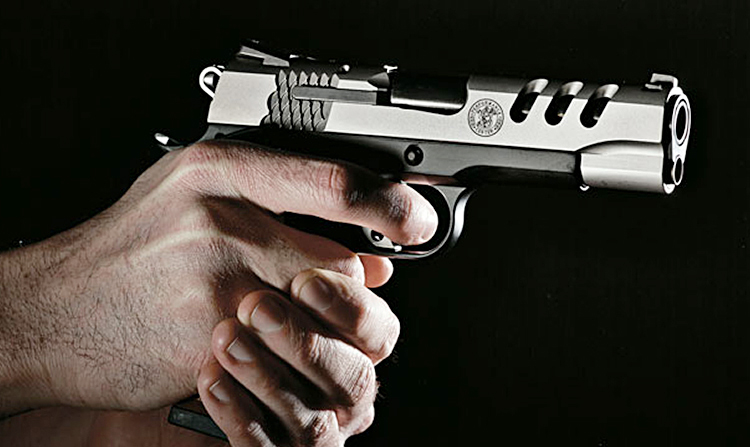Trigger break is the “last thing” that happens in making an accurate shot, and if it’s not done well, you’ll probably miss… Here’s how to fix it.
SOURCE: NRAFamily.org, George Harris
The Problem: Up until this point in your firearm training, the emphasis had been on achieving an acceptable sight picture and squeezing the trigger in a slow and steady manner until the gun fired as a surprise. That had been working fairly well, until you attended a tactical shooting class where all the drills and exercises were timed. Your shots were so slow, the instructor joked about getting a sundial to time you. His emphasis was making a relatively accurate shot in minimum time, which he referred to as command detonation. By the end of the class you had developed a command trigger jerk, as well as a pretty significant flinch to go along with it. You see the value of making a shot on demand, especially in a defensive situation, but hitting the intended target while jerking the trigger and flinching as well is iffy at best. The Solution: The objective of shooting is hitting your target. With that in mind, a person can’t shoot fast enough while missing the target to accomplish anything but the expenditure of ammunition. A good axiom to go by is: Shoot only as fast as you can hit your target. Keeping that in mind, it seems like perhaps you need to redirect your thinking a bit to speed up your shot delivery.
The first thing to do is remove the word “squeeze” from your vocabulary when referencing trigger operation. Squeeze in any other sense of the word means compressing all of your fingers as well as the palm of the hand together to hold or apply pressure to an object. Think of squeezing a tube of toothpaste or the hand of another with whom you don’t want to lose contact. Making those types of motion with a gun in hand will cause the muzzle to move off the target, low and to the inside as the trigger is being moved to the rear, therefore resulting in a miss.
In this case the trigger jerk comes from the tightening of the whole hand on the gun trying to make the shot as quickly as possible without regard to the muzzle’s position on the target. The flinch is usually a result of several stimuli that trigger responses in the emotional mind. Think fight-or-flight, self-preservation response, or the subconscious response to an unexpected or surprise event.
Being under the assumption you have undergone the noise- and recoil-inoculation drills in your previous training (both of which will all but eliminate the tendency to move involuntarily — flinch — when the gun fires) likely leaves the sound of the beep (go signal) as the likely culprit for the cause of trigger jerk. This is because it comes unexpectedly at random times which, for lack of a better phrase, scares you into action.
One of the methods we use to overcome the phenomenon of trigger jerk is simply to listen to the “go signal” while thinking that this signal is permission to do something you like to do. That is to shoot. This puts your brain into a “Let’s do it!” perspective as opposed to an “Oh $@&*%!” response when the signal is given.
The next step is to correct the deficiencies in trigger jerk, grip and trigger manipulation to where the trigger finger can move at any speed, independent of the rest of the hand, without affecting the position of the muzzle on the target. This can be done dry with the “Wall Drill,” which will give the basis for the live-fire segment, which we call the “Now Drill.” Try it without the beep at first, then integrate the beep once the trigger can be quickly and smoothly operated without moving the muzzle.
The “Now Drill” is a really simple exercise for the experienced shooter. A good starting point for a shooter new to the concept is placing an 8-inch paper plate at 7 yards while standing with the finger on the trigger, aiming at the plate, waiting for the command to fire. When the signal to fire is given, the initial goal is to hit the plate in one second or less with one shot. As proficiency and skill improve, times can be shortened and distances increased to further the challenge of shooting an accurate shot on demand.
A cautionary note should be included for this drill. Regardless of whether you call it command detonation, the now drill, or anything else, the student should have basic marksmanship skills firmly ingrained and extensively practiced well beforehand. This will lessen the likelihood of creating unnecessary problems such as a trigger jerk or a flinch when trying to increase their speed.
He who hits first wins, regardless of the speed of the opponent’s miss.









